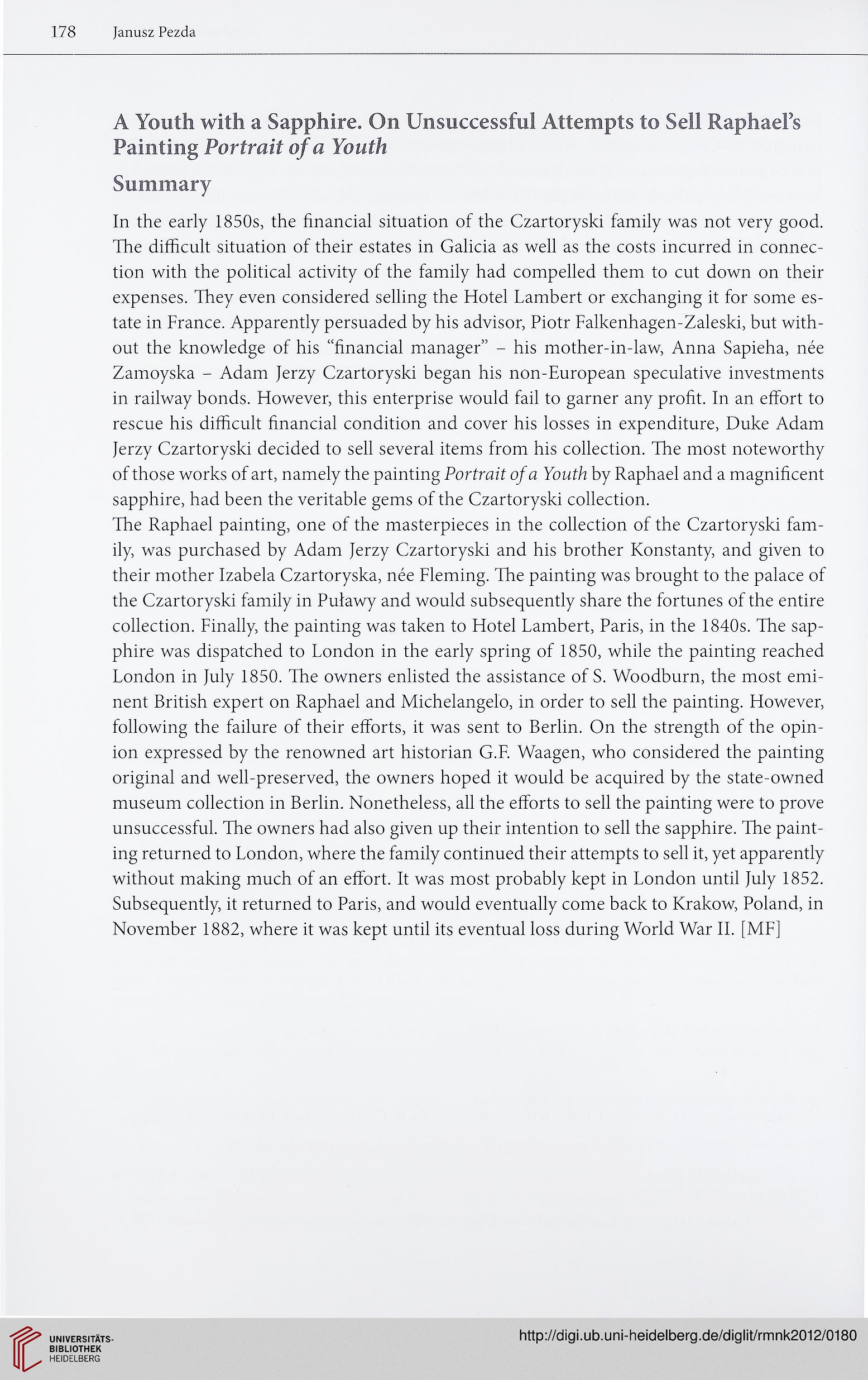178 Janusz Pezda
A Youth with a Sapphire. On Unsuccessful Attempts to Sell RaphaeFs
Painting Portrait ofa Youth
Summary
In the early 1850s, the financial situation of the Czartoryski family was not very good.
The difficult situation of their estates in Galicia as well as the costs incurred in connec-
tion with the political activity of the family had compelled them to cut down on their
expenses. They even considered selling the Hotel Lambert or exchanging it for sonie es-
tate in France. Apparently persuaded by his advisor, Piotr Falkenhagen-Zaleski, but with-
out the knowledge of his “financial manager” - his mother-in-law, Anna Sapieha, nee
Zamoyska - Adam Jerzy Czartoryski began his non-European speculative investments
in railway bonds. However, this enterprise would fail to garner any profit. In an effort to
rescue his difficult financial condition and cover his losses in expenditure, Duke Adam
Jerzy Czartoryski decided to sell several items from his collection. The most noteworthy
of those works of art, namely the painting Portrait ofa Youth by Raphael and a magnificent
sapphire, had been the veritable gems of the Czartoryski collection.
The Raphael painting, one of the masterpieces in the collection of the Czartoryski fam-
ily, was purchased by Adam Jerzy Czartoryski and his brother Konstanty, and given to
their mother Izabela Czartoryska, nee Fleming. The painting was brought to the pałace of
the Czartoryski family in Puławy and would subseąuently share the fortunes of the entire
collection. Finally, the painting was taken to Hotel Lambert, Paris, in the 1840s. The sap-
phire was dispatched to London in the early spring of 1850, while the painting reached
London in July 1850. The owners enlisted the assistance of S. Woodburn, the most emi-
nent British expert on Raphael and Michelangelo, in order to sell the painting. However,
following the failure of their efforts, it was sent to Berlin. On the strength of the opin-
ion expressed by the renowned art historian G.F. Waagen, who considered the painting
original and well-preserved, the owners hoped it would be acquired by the state-owned
museum collection in Berlin. Nonetheless, all the efforts to sell the painting were to prove
unsuccessful. The owners had also given up their intention to sell the sapphire. The paint-
ing returned to London, where the family continued their attempts to sell it, yet apparently
without making much of an effort. It was most probably kept in London until July 1852.
Subseąuently, it returned to Paris, and would eventually come back to Kraków, Poland, in
November 1882, where it was kept until its eventual loss during World War II. [MF]
A Youth with a Sapphire. On Unsuccessful Attempts to Sell RaphaeFs
Painting Portrait ofa Youth
Summary
In the early 1850s, the financial situation of the Czartoryski family was not very good.
The difficult situation of their estates in Galicia as well as the costs incurred in connec-
tion with the political activity of the family had compelled them to cut down on their
expenses. They even considered selling the Hotel Lambert or exchanging it for sonie es-
tate in France. Apparently persuaded by his advisor, Piotr Falkenhagen-Zaleski, but with-
out the knowledge of his “financial manager” - his mother-in-law, Anna Sapieha, nee
Zamoyska - Adam Jerzy Czartoryski began his non-European speculative investments
in railway bonds. However, this enterprise would fail to garner any profit. In an effort to
rescue his difficult financial condition and cover his losses in expenditure, Duke Adam
Jerzy Czartoryski decided to sell several items from his collection. The most noteworthy
of those works of art, namely the painting Portrait ofa Youth by Raphael and a magnificent
sapphire, had been the veritable gems of the Czartoryski collection.
The Raphael painting, one of the masterpieces in the collection of the Czartoryski fam-
ily, was purchased by Adam Jerzy Czartoryski and his brother Konstanty, and given to
their mother Izabela Czartoryska, nee Fleming. The painting was brought to the pałace of
the Czartoryski family in Puławy and would subseąuently share the fortunes of the entire
collection. Finally, the painting was taken to Hotel Lambert, Paris, in the 1840s. The sap-
phire was dispatched to London in the early spring of 1850, while the painting reached
London in July 1850. The owners enlisted the assistance of S. Woodburn, the most emi-
nent British expert on Raphael and Michelangelo, in order to sell the painting. However,
following the failure of their efforts, it was sent to Berlin. On the strength of the opin-
ion expressed by the renowned art historian G.F. Waagen, who considered the painting
original and well-preserved, the owners hoped it would be acquired by the state-owned
museum collection in Berlin. Nonetheless, all the efforts to sell the painting were to prove
unsuccessful. The owners had also given up their intention to sell the sapphire. The paint-
ing returned to London, where the family continued their attempts to sell it, yet apparently
without making much of an effort. It was most probably kept in London until July 1852.
Subseąuently, it returned to Paris, and would eventually come back to Kraków, Poland, in
November 1882, where it was kept until its eventual loss during World War II. [MF]




